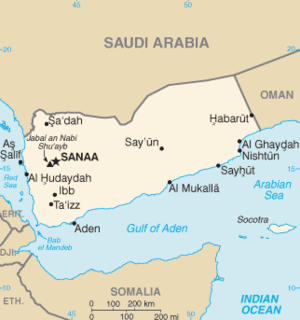Treaty of Jeddah (2000)

The 2000 Treaty of Jeddah resolved a border dispute between Saudi Arabia and Yemen dating back to Saudi boundary claims made in 1934.[1][2]
Background
The long running dispute arose from the 1934 Treaty of Taif between Yemen and the newly-formed Saudi Arabia and the subsequent demarcation of the boundary three years later. Ambiguity in the placement of the border led to competing claims by Saudi Arabia and Yemen for the remainder of the twentieth century, complicated by traditional pre-colonial claims, crude border-marker placement and uncertainty as to the exact mountain peak named in the original treaty text.[2] By the mid-1990s, governments of both nations acknowledged the need for a clear and mutually-agreed border, first with a Memorandum of Understanding dated February 1995, and then with a meeting at Lake Como, Italy that created the provisional "Como Line" in the summer of 1997. [3]
However progress would stall over the next three years, in part as the nations contested the exact placement of the maritime portion of the border as it met the Red Sea. This led to a series of border clashes, including confrontation between Yemeni and Saudi Arabian armed forces over Duwaimah Island (located south of the Farasan Islands) in July 1998. [4]
Signing
In May 2000, Crown Price Abdullah of Saudi Arabia attended Yemen for the first time to commemorate the tenth anniversary of the unification of North and South Yemen. Shortly after this meeting, and a series of intensive diplomatic talks, the two governments finally signed the Treaty of Jeddah in the Saudi port city on 12 June 2000 to take effect the following month. The signatories of the treaty were the Foreign Ministers of both nations as well as Yemeni Deputy Prime Minister Abd al-Rahman Bagammal. The treaty gave exact coordinates for the land and maritime border and included provisions for the pastoral rights of shepherds, placement of armed forces and future natural wealth extraction along the border. [2][5]
Aftermath
In 2003 Saudi Arabia began construction of a border wall with Yemen citing organised smuggling and security concerns. Following international diplomatic pressure and accusations that this violated the 20km buffer zone reserved for grazing in the 2000 treaty, Saudi Arabia agreed to halt construction and both sides to uphold the treaty in February 2004.[6]. However, Saudi Arabia would subsequently complete the wall between 2009-2010. The border has become increasingly patrolled and crossings restricted following the destabilising effects of the 2011 Yemeni Revolution and subsequent Saudi Arabian involvement in the ongoing Yemeni Civil War.[7]
See also
References
- ^ The Treaty of Jeddah, 2000 Archived 2014-03-06 at the Wayback Machine, Al-Bab.com, June 22, 2000. Accessed February 9, 2010.
- ^ a b c Askar Halwan Al-Enazy (January 2002). ""The International Boundary Treaty" (Treaty of Jeddah) Concluded between the Kingdom of Saudi Arabia and the Yemeni Republic on June 12, 2000". American Journal of International Law. 96 (1): 161–173. JSTOR 2686133.
- ^ Charney, Jonathan; Lewis, Alexander; Smith, Robert (16 October 2002). International Maritime Boundaries Volume 4. Martinus Nijhoff Publishers. p. 2800. Retrieved 14 March 2020.
- ^ https://mepc.org/journal/saudi-arabian-yemeni-relations-implications-us-policy
- ^ https://al-bab.com/treaty-jeddah-2000
- ^ http://news.bbc.co.uk/1/hi/world/middle_east/3495533.stm
- ^ https://www.ncbi.nlm.nih.gov/pmc/articles/PMC6019222/
